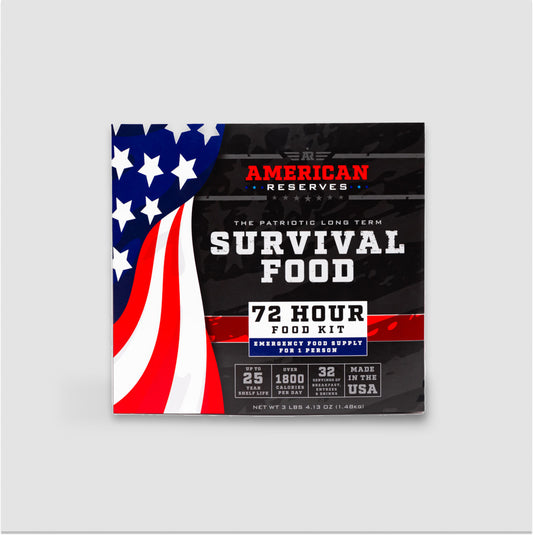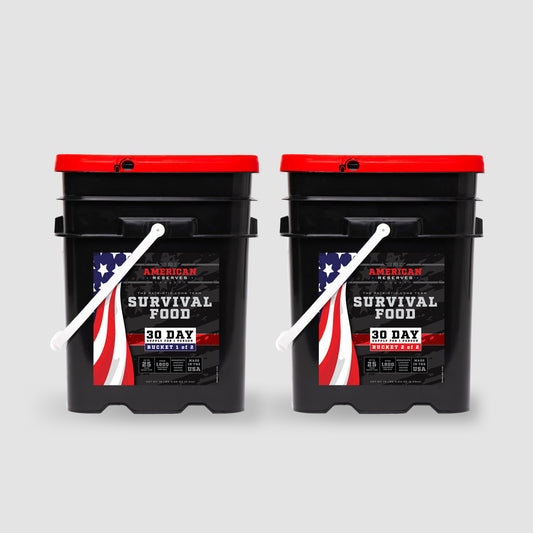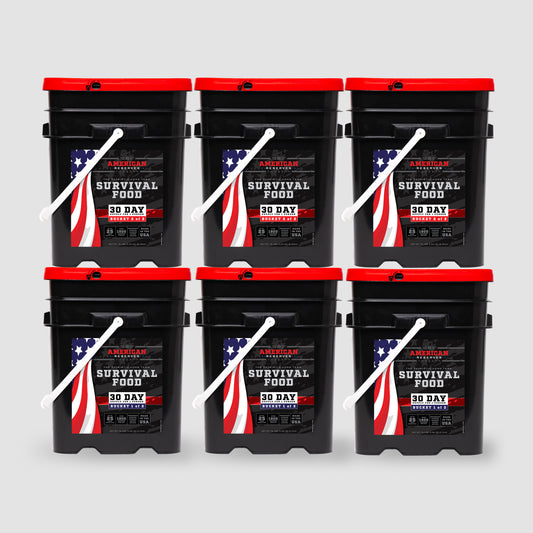
How To Store Survival Food: Step-by-Step
With the increasing frequency of natural disasters and economic fluctuations, knowing how to store survival food has never been more crucial. This comprehensive guide provides a detailed, step-by-step approach to building a sustainable and organized food storage system. By following these expert recommendations, readers can achieve a heightened sense of security and readiness, ensuring their loved ones are protected in times of crisis.
Why Storing Survival Food Properly Matters
Storing survival food properly is crucial for ensuring the longevity, safety, and nutritional value of your emergency supplies. Proper storage techniques protect food from spoilage, contamination, and nutrient loss, which can be vital during a crisis when access to fresh food is limited. By following best practices for food storage, individuals can maintain a reliable and organized supply that provides peace of mind and security for their families. This preparedness not only enhances self-reliance but also ensures that, in times of need, there is a dependable source of sustenance to support health and well-being.
How To Store Survival Food
Step 1: Choose the Right Foods
Select non-perishable items with long shelf lives, such as canned goods, dried beans, rice, pasta, and freeze-dried meals. Avoid foods with high moisture content or those prone to spoilage, as they can quickly become unsafe to consume.
Step 2: Clean and Dry Foods
Ensure all foods are clean and thoroughly dried before storage. This helps prevent mold and bacterial growth, which can compromise the safety and longevity of your supplies, ensuring they remain edible for extended periods.
Step 3: Use Proper Packaging
Utilize airtight containers, vacuum-sealed bags, or Mylar bags with oxygen absorbers to protect food from air, moisture, and pests. Proper packaging is essential for maintaining freshness and preventing contamination, thereby extending the shelf life of your food.
Step 4: Label and Date Everything
Clearly label each container with the contents and the date of storage. This practice aids in inventory management and ensures that older items are used first, reducing waste and helping you keep track of your food supply's age.
Step 5: Store in Optimal Conditions
Keep your food storage in a cool, dry, and dark place. Ideal temperature ranges are between 50°F and 70°F, with low humidity levels to prevent spoilage and pest infestations, ensuring your food remains in the best possible condition.
Step 6: Organize and Rotate Stock
Arrange your food supplies in an orderly manner, with the oldest items at the front. Regularly rotate your stock by using older items first and replenishing with new supplies to maintain a fresh and reliable inventory, ensuring nothing goes to waste.
Step 7: Conduct Regular Inspections
Periodically check your food storage for signs of spoilage, pests, or damage. Replace any compromised items immediately to ensure the integrity of your emergency food supply, maintaining its safety and reliability.
Step 8: Replenish and Update
Consistently update your inventory and replenish your stock as needed. Stay informed about the shelf life of stored items and replace them before they expire to maintain a dependable and nutritious food supply, ensuring you are always prepared.
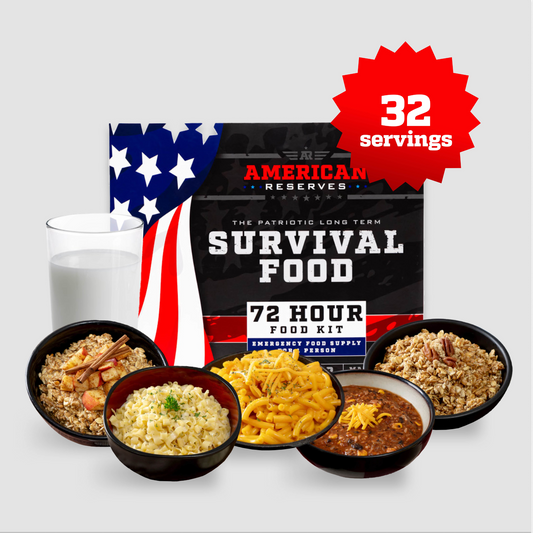
72 Hour Emergency Food and Drink Supply - 32 Servings
$36.99
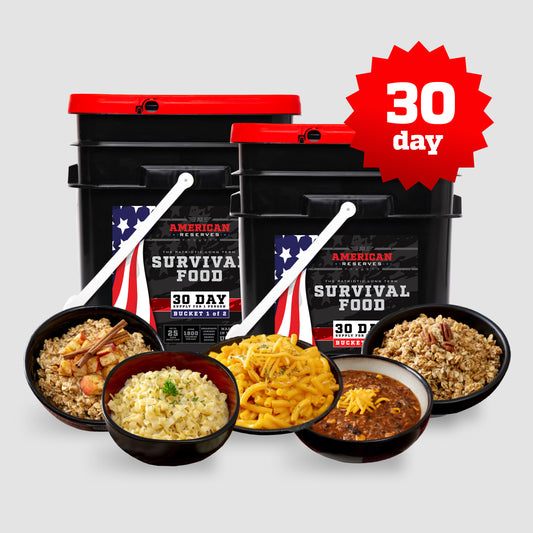
30 Day Emergency Food Supply
$319.99
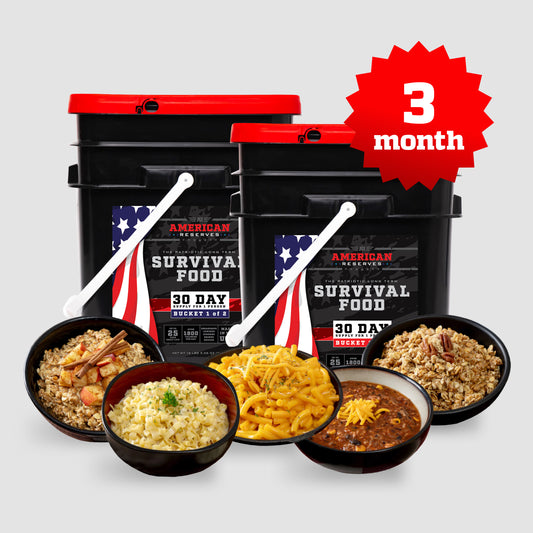
3 Month Emergency Food Supply
$835.00
Where Is The Best Place To Store Survival Food?
The best place to store survival food is in a cool, dry, and dark environment, such as a basement, pantry, or dedicated storage room. These conditions help maintain the optimal temperature range of 50°F to 70°F, which is crucial for preserving the quality and longevity of your food supplies. Additionally, low humidity levels prevent moisture-related issues like mold and spoilage, while darkness protects against nutrient degradation caused by light exposure. Ensuring the storage area is clean and free from pests further safeguards your food, providing a reliable and secure supply for emergencies.
Does Survival Food Go Bad?
Yes, survival food can go bad if not stored properly or if it exceeds its shelf life. Factors such as exposure to air, moisture, light, and fluctuating temperatures can accelerate spoilage and reduce the nutritional value of stored food. Even non-perishable items have a finite shelf life, and over time, their quality and safety can deteriorate. Proper storage techniques, including using airtight containers, maintaining optimal environmental conditions, and regularly inspecting and rotating stock, are essential to prolong the usability of survival food. By adhering to these practices, individuals can ensure their emergency food supply remains safe and effective for as long as possible. For best results, look for high-quality survival food kits with up to 25 years of shelf-life.
What Foods Should I Stockpile For Survival?
- Canned Goods
- Vegetables
- Fruits
- Meats (chicken, tuna, beef)
- Soups and stews
- Dried Foods
- Beans
- Lentils
- Rice
- Pasta
- Grains and Cereals
- Rice
- Oats
- Quinoa
- Barley
- Wheat
- Freeze-Dried Meals
- Complete meal kits with balanced nutrition
- Individual ingredients (vegetables, meats)
- Dehydrated Foods
- Fruits (apples, bananas, berries)
- Vegetables (carrots, peas, corn)
- Nuts and Seeds
- Almonds
- Walnuts
- Sunflower seeds
- Chia seeds
- Powdered and Shelf-Stable Dairy
- Milk powder
- Cheese powder
- Shelf-stable milk
- Baking Essentials
- Flour
- Sugar
- Baking powder
- Yeast
- Oils and Fats
- Olive oil
- Coconut oil
- Ghee
- Condiments and Spices
- Salt
- Pepper
- Honey
- Vinegar
- Beverages
- Coffee
- Tea
- Drink mixes (electrolyte powders)
- Snacks and Comfort Foods
- Crackers
- Granola bars
- Chocolate
- Peanut butter
Should I Store My Survival Food In The Freezer?
Storing survival food in the freezer can be beneficial for certain items, such as meats, vegetables, and prepared meals, as it helps with the preservation of their freshness and nutritional value for extended periods. However, relying solely on the freezer for long-term survival food storage is not advisable due to potential power outages during emergencies, which could lead to spoilage. Instead, a balanced approach that includes a variety of non-perishable, shelf-stable foods and canning methods stored in optimal conditions is recommended. This ensures a reliable food supply that remains unaffected by power disruptions, providing greater security and peace of mind during crises.
What's The Best Place To Store Water In a Disaster or Survival Situation?
The best place to store water in a disaster or survival situation is in a cool, dark, and dry location, such as a basement, pantry, or dedicated storage area. These conditions help prevent the growth of algae and bacteria, ensuring the water remains safe to drink and reducing the risk of dehydration. Use food-grade containers, such as BPA-free plastic bottles, stainless steel containers, or water storage barrels, to avoid contamination. It's also essential to keep the water supply away from chemicals, gasoline, and other hazardous substances that could compromise its safety. Regularly rotate and inspect your water storage to maintain its quality, ensuring you have a dependable and clean water supply when needed most.
Is It Easier To Store Freeze Dried Foods or Dehydrated Foods?
Storing freeze-dried foods is generally easier and more advantageous than storing dehydrated foods due to their longer shelf life, lighter weight, and superior preservation of nutrients and flavor. Freeze-dried foods typically retain up to 97% of their original nutrients and can last up to 25 years when stored properly, whereas dehydrated foods have a shorter shelf life and may lose more nutritional value during the drying process. Additionally, freeze-dried foods rehydrate more quickly and maintain their texture and taste better than dehydrated foods. Both types require similar storage conditions—cool, dry, and dark environments—but the extended longevity and quality retention make freeze-dried foods a more convenient and reliable option for long-term survival food storage.
Tips For Proper Survival Food Storage
- Use Airtight Containers: Store food in airtight containers to protect against moisture, air, and pests, ensuring maximum freshness and longevity.
- Maintain Optimal Conditions: Keep your storage area cool, dry, and dark, ideally between 50°F and 70°F, to prevent spoilage and nutrient degradation.
- Label and Date: Clearly label each container with its contents and the date of storage to facilitate inventory management and ensure older items are used first.
- Rotate Stock Regularly: Practice the "first in, first out" method by regularly rotating your stock, using older items before newer ones to maintain a fresh supply.
- Inspect Periodically: Conduct regular inspections for signs of spoilage, pests, or damage, and replace any compromised items immediately to maintain the integrity of your food supply.
Conclusion
In conclusion, mastering the art of storing survival food is a crucial step toward ensuring the safety and well-being of your family during emergencies. By selecting the right foods, employing proper storage techniques, and maintaining optimal conditions, individuals can build a reliable and nutritious food supply that stands the test of time. Whether choosing freeze-dried or dehydrated options, the key lies in careful planning, organization, and regular maintenance. With these strategies in place, you can achieve a heightened sense of preparedness and peace of mind, knowing that you are well-equipped to face any unforeseen challenges with confidence and resilience.
Final Thoughts
With a strong foundation in emergency and survival expertise, American Reserves delivers top-tier preparedness solutions. Our emergency food supply kits, composed of premium locally sourced ingredients from the USA, ensure you receive essential nutrition in emergencies. Count on American Reserves to keep you ready for any challenge.
Sources
